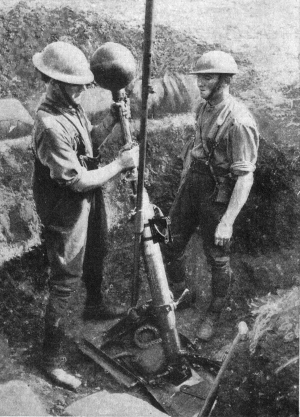2 inch Medium Mortar
| 2-inch Medium Mortar | |
|---|---|

British troops loading a 2 inch trench mortar with attached periscope post, World War I. This appears to be a training exercise as no fuze is visible.
|
|
| Type | Medium mortar |
| Place of origin | United Kingdom |
| Service history | |
| In service | 1915 - 1917 |
| Used by | British Empire |
| Wars | World War I |
| Production history | |
| Designer | Royal Ordnance Factory |
| Manufacturer | various contractors |
| Number built | 1907 |
| Specifications | |
| Weight | 105 lb (48 kg) |
| Barrel length | bore: 3 ft (0.91 m) total: 3 ft 5 in (1.04 m) |
| Crew | 5 per mortar 25 per battery of 4 |
|
|
|
| Shell |
HE 51 lb (23 kg) Smoke |
| Calibre | 2 inch (50.8 mm) mortar barrel, not bomb |
| Rate of fire | 2-3 per minute |
| Effective firing range | 100 yd (90 m) min 570 yd (520 m) max depending on charge |
| Filling | Amatol or Ammonal |
| Filling weight | 12.5 lb (5.6 kg) |
The 2 inch Medium Trench Mortar, also known as the 2-inch Howitzer, and nicknamed the "Toffee Apple" or "Plum Pudding" mortar, was a British smooth bore muzzle loading (SBML) medium trench mortar in use in World War I from mid-1915 to mid-1917. The designation "2 inch" refers to the mortar barrel, into which only the 22-inch bomb shaft but not the bomb itself was inserted; the spherical bomb itself was actually 9 inches (230 mm) in diameter and weighed 42 lb (19 kg), hence this weapon is more comparable to a standard mortar of approximately 5-6 inch bore.
As the Western Front in France and Belgium stagnated into trench warfare in late 1914, British forces found themselves with no means of replying to the German minenwerfers (trench mortars) which were lobbing both small and large (over 100 pound) high-explosive shells into their frontline trenches from short range. British commanders requested an accurate short-range weapon which was manually portable in the trenches, could be safely used to attack enemy trenches as close as 100 yards to the British trenches, was easily concealed and projected a reasonably large explosive charge capable of damaging protected enemy positions. The British Expeditionary Force had been expected to participate only in mobile warfare and was not equipped with any mortars.
Various alternative designs for light and medium mortars were evaluated, prompted by the need to place at least some weapon into action without diverting manufacturing capacity from guns and howitzers, which weapons were given priority. Hence the emphasis was on designs for both mortar and ammunition that could be manufactured by small unsophisticated workshops unsuited to other war work:
This was designed and manufactured by the Royal Ordnance Factories in early 1915 and introduced along with the 1.57 inch mortar in March 1915. It incorporated what was known of the German prewar Krupp mortar. This was the first design to meet all the requirements, after modifications to simplify manufacture; it fired a good-sized spherical cast-iron bomb of 42 pounds (total projectile weight 51 pounds with stick and fuze), considered the largest practical size for use from trenches, at ranges from 100 to 600 yards using a simple 2-inch tube as the mortar body. The mortar and ammunition could be cheaply manufactured by small unsophisticated "trade" workshops; the bomb was safely detonated by a standard No. 80 "time and percussion" artillery fuze. Drawbacks were that the steel tail was usually projected backwards towards the firer when the bomb detonated, resulting in occasional casualties and the No. 80 fuze was also required by the 18-pounder field guns which were given priority, limiting mortar ammunition supply to the front until early 1916 when a special cheap trench mortar fuze was developed.
...
Wikipedia
